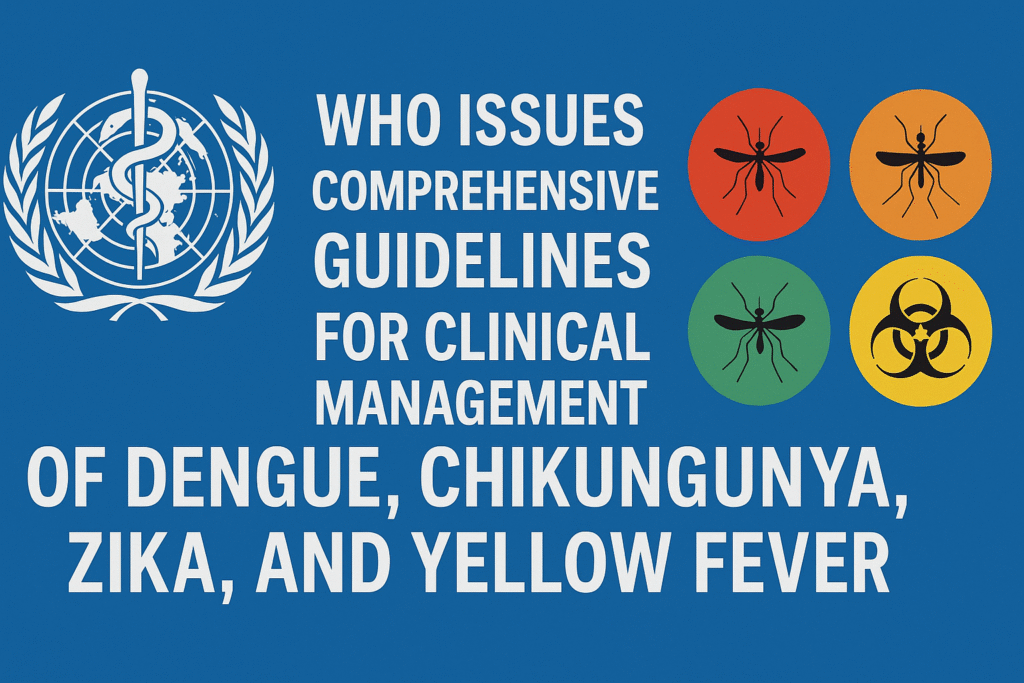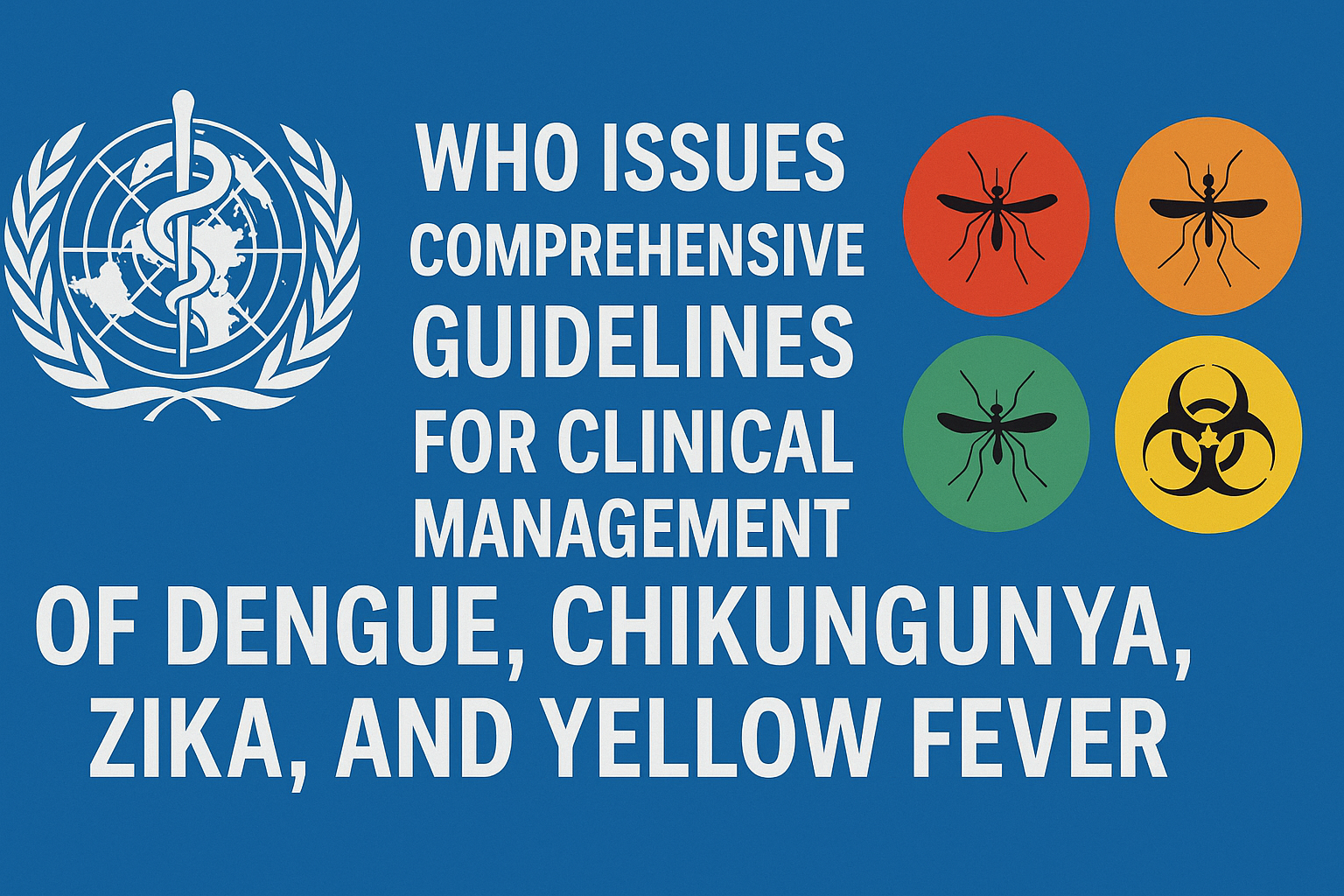In July 2025, the World Health Organization (WHO) released its first integrated clinical guidelines for managing arboviral diseases, specifically targeting dengue, chikungunya, Zika, and yellow fever.
These mosquito-borne viral infections, primarily transmitted by Aedes species mosquitoes, pose a significant global health threat, with over 5.6 billion people at risk due to climate change, urbanization, and increased human mobility.
These guidelines aim to equip healthcare providers with evidence-based strategies to improve patient outcomes, prevent severe disease progression, and reduce mortality in a context where these diseases often present with overlapping symptoms and diagnostic challenges.

The Growing Threat of Arboviral Diseases
Arboviral diseases, transmitted by arthropod vectors like mosquitoes, are a major public health concern, particularly in tropical and subtropical regions. Dengue alone affects an estimated 100–400 million people annually, with 2024 reporting over 14.2 million cases globally, including 7.5 million confirmed cases and over 10,000 deaths, predominantly in the Americas.
Chikungunya has seen over 460,000 suspected cases in 2024, with local transmission in 119 countries, while Zika reported over 30,000 cases, primarily in the Americas. Yellow fever, though less prevalent, remains a significant concern due to its high mortality rate in severe cases.
The expansion of Aedes aegypti and Aedes albopictus mosquitoes into new regions, driven by global warming and urbanization, has heightened the risk of outbreaks, even in temperate climates like parts of Europe.
These diseases often present with similar clinical features, such as fever, rash, myalgia, and arthralgia, making differential diagnosis challenging, especially in areas with limited access to specific diagnostic tests.
Co-circulation of multiple arboviruses in the same region further complicates clinical management, as does the potential for severe outcomes, such as dengue shock syndrome, congenital Zika syndrome, or chronic joint pain following chikungunya.
The WHO guidelines address these complexities by providing a unified framework for diagnosis, treatment, and prevention.
Key Features of the WHO Guidelines
The WHO guidelines, developed by a Guideline Development Group (GDG) with expertise across multiple specialties and WHO regions, focus on evidence-based recommendations for managing patients with suspected or confirmed arboviral infections.
These guidelines replace previous WHO guidance, superseding older recommendations to reflect the latest clinical and epidemiological data. They are designed for use across all levels of healthcare systems, including community-based care, primary care, emergency departments, and hospital wards, ensuring applicability in diverse settings.
Clinical Diagnosis and Differential Challenges
Accurate diagnosis is critical but challenging due to symptom overlap and the lack of widely available, reliable laboratory tests in many affected areas. For instance, dengue, chikungunya, and Zika can all present with fever, rash, and joint pain, resembling other febrile illnesses like malaria or leptospirosis.
The guidelines recommend nucleic acid amplification tests (NAATs), such as RT-PCR, as the preferred method for confirming infections in the acute phase due to their ability to distinguish specific viruses. However, where NAATs are unavailable, immunoglobulin M (IgM) antibody testing can be used, though cross-reactivity between dengue and Zika complicates interpretation.
Clinicians are urged to consider epidemiological risk factors, such as recent travel to endemic areas, and to monitor for warning signs like persistent vomiting or mucosal bleeding in dengue cases.
Management of Non-Severe and Severe Cases
The guidelines provide detailed recommendations for managing both non-severe and severe arboviral illnesses. For non-severe cases, supportive care is emphasized, including hydration, rest, and symptom relief with acetaminophen, while non-steroidal anti-inflammatory drugs (NSAIDs) are discouraged due to bleeding risks in dengue.
For severe cases, such as dengue shock syndrome or yellow fever requiring hospitalization, the guidelines outline specific fluid management protocols to address hypovolemic shock and plasma leakage. For yellow fever, adjunctive therapies are recommended, though antiviral treatments like sofosbuvir are only advised in research settings due to insufficient evidence from randomized controlled trials.
Special attention is given to vulnerable populations, such as pregnant women, children, and older adults. For example, Zika infection during pregnancy requires careful monitoring due to the risk of congenital anomalies like microcephaly.
The guidelines also address post-infection complications, such as Guillain-Barré syndrome associated with Zika or chronic joint pain following chikungunya, recommending long-term follow-up care.
Preventive Measures and Vaccination
Prevention remains a cornerstone of arboviral disease control, with the guidelines emphasizing vector control strategies, such as eliminating mosquito breeding sites, using insect repellents, and wearing protective clothing.
Yellow fever has an effective vaccine providing lifelong immunity, but vaccines for dengue (e.g., QDENGA®) and chikungunya are limited in their public health application, and no Zika vaccine is currently available. The guidelines caution against using the dengue vaccine in individuals without prior exposure due to the risk of severe disease in subsequent infections.
Implementation and Policy Implications
Beyond clinical recommendations, the guidelines serve as a resource for policymakers and health managers to develop national and regional protocols for epidemic preparedness. They address barriers to implementation, such as limited diagnostic resources and healthcare infrastructure in low-resource settings, and suggest strategies like training healthcare workers and strengthening surveillance systems.
The WHO emphasizes the need for clinicians to recognize these diseases early and apply evidence-based care to prevent severe outcomes, particularly in regions where multiple arboviruses co-circulate.
Advancements and Future Directions
The guidelines highlight ongoing research into antiviral therapies, such as chloroquine and niclosamide, which have shown promise against arboviruses in preclinical studies.
Innovative vector control methods, like Wolbachia-infected mosquitoes, are also noted for their potential to reduce transmission. However, the WHO underscores the need for continued research into vaccines and treatments, as well as global collaboration to address the growing burden of arboviral diseases.
Conclusion
The WHO’s integrated guidelines for dengue, chikungunya, Zika, and yellow fever mark a significant step toward standardizing clinical management in the face of a growing global health threat.
By providing clear, evidence-based recommendations, the guidelines empower healthcare providers to navigate diagnostic challenges, manage diverse patient populations, and prevent severe outcomes.
As arboviral diseases continue to spread to new regions, these guidelines will play a critical role in enhancing preparedness and improving patient care worldwide.
